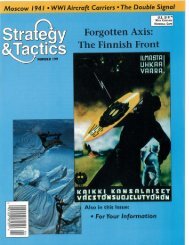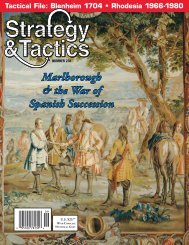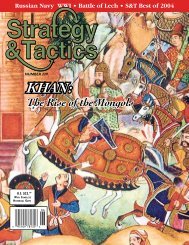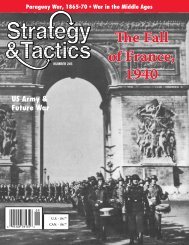COUNTERSTROKE AT SOLTSY - Strategy & Tactics Press
COUNTERSTROKE AT SOLTSY - Strategy & Tactics Press
COUNTERSTROKE AT SOLTSY - Strategy & Tactics Press
You also want an ePaper? Increase the reach of your titles
YUMPU automatically turns print PDFs into web optimized ePapers that Google loves.
thunderball<br />
The rescue mission was code-named Operation<br />
Thunderball (in some sources, Thunderbolt),<br />
and on the morning of 2 July several young Israeli<br />
men rented a couple of twin-engine planes<br />
at Wilson Airport outside Nairobi, Kenya. Their<br />
specified destination was the Kenyan coastal<br />
city of Kisumu, but instead they headed for Entebbe.<br />
They circled the airport and nearby Lake<br />
Victoria, exposing multiple rolls of film as they<br />
photographed the runways and all buildings and<br />
the roads leading to them. After the youthful<br />
spies shot every frame they had, they flew on to<br />
Kisumu, then back to Nairobi, from where they<br />
hastily departed. No one in Entebbe noticed the<br />
aviators winging overhead that morning. Thunderball<br />
was beginning. Netaniahu used their photographs<br />
to enhance the training of his men using<br />
mock-ups of the Entebbe terminal.<br />
During the three days since the rescue plan<br />
had been proposed, the IDF had learned there<br />
were three doors into Old Terminal; terrorists<br />
were standing guard in twos and threes (mostly<br />
by the doors); terrorists not on guard were resting<br />
in a side room; Ugandan soldiers were stationed<br />
on the Old Terminal’s second floor, and the control<br />
tower was roughly the height of a four-story<br />
building, commanding a view of the entire area.<br />
Using that data, Netaniahu had his men build a<br />
sandbag rampart, complete with openings, to the<br />
dimensions of the wall encircling Old Terminal.<br />
Playing the parts of rescuers, terrorists and hostages,<br />
the commandoes tirelessly practiced their<br />
upcoming mission.<br />
The commandoes also purchased an old white<br />
Mercedes at a used car lot and drove it to the assembly<br />
area, where it was meticulously serviced<br />
and painted black so as to look like Amin’s favorite<br />
vehicle. When the action started, that car<br />
would be a centerpiece of the Israeli tactics.<br />
Meanwhile, Radio Israel was repeating the<br />
claim its government would be bargaining with<br />
the terrorists momentarily, shattering the country’s<br />
morale while lulling the hijackers into believing<br />
they had won. The PFLP was demanding<br />
the terrorists whose release it sought be brought<br />
to Entebbe before the hostages would be freed.<br />
The long-distance exchange would give the Israelis<br />
an excuse to take even longer to “comply,”<br />
and the time was being well spent.<br />
As the rescue mission prepared to kick off,<br />
disturbing intelligence reports began arriving<br />
from Uganda—the terrorists were not so much<br />
interested in freeing their imprisoned comrades as<br />
they were in humiliating Israel before the whole<br />
world. More details out of Entebbe pointed to the<br />
hijackers planning to hang on to the captives af-<br />
the terrorists<br />
At the time of the Entebbe affair, Dr. Wadia<br />
Hadad (a dentist) was the most dangerous man on<br />
Israel’s most-wanted list. Forsaking dentistry for<br />
terrorism, he took his new calling seriously. Unlike<br />
other terror paladins, he was virtually never seen<br />
in public and was careful not to allow himself to<br />
be photographed. After narrowly escaping death in<br />
a 1970 Katyusha rocket attack on his Beirut apartment,<br />
Hadad was terrified of assassination, staying<br />
hidden and constantly on the move. A photograph<br />
allegedly of him printed in newspapers worldwide<br />
following the Entebbe hijacking was a fake.<br />
In the 1950s Hadad had joined forces with an<br />
optician by the name of George Habash. Opening<br />
a joint medical practice, they also founded<br />
the Kaumion el-Arab (Arab Nationalism Movement).<br />
Following the 1967 Six-Day War, Hadad<br />
changed his organization’s name to the Popular<br />
Front for the Liberation of Palestine (PFLP), and<br />
began directing international terror attacks, attempting<br />
to assassinate Israeli founding father<br />
David Ben-Gurion He later received 5 million<br />
dollars in exchange for the release of a hijacked<br />
Lufthansa airliner.<br />
Part of that ransom was used to pay the<br />
Japanese Red Army to send some of their men<br />
to fight as mercenaries for the PFLP and attack<br />
travelers in Israel’s Lod Airport in 1972. With<br />
a keen mind for finances, Hadad realized huge<br />
sums of money were essential to establish an international<br />
terror infrastructure, with himself as<br />
commander. Apart from ransom and widespread<br />
robberies of banks (mostly in Lebanon), there<br />
were enormous contributions from oil-rich Libya,<br />
Iraq and South Yemen. Additional income<br />
came from smuggling stolen automobiles from<br />
Europe into the Middle East. The man Hadad<br />
placed in charge of the massive car theft ring<br />
was Faiz Jaaber, who would later participate in<br />
(and be killed during) the Entebbe operation.<br />
Hadad and his subordinates also invested in<br />
Arab financial houses that provided steady, dependable<br />
profits. The huge volume of money supported<br />
terror cells and sanctuaries throughout the<br />
Mideast and Europe.<br />
Hadad eventually became too radical for Habash,<br />
and the two parted ways after the Lod attack,<br />
which Habash had not sanctioned. Late in<br />
June 1976, Hadad arrived in Mogadishu, Somalia,<br />
to direct his latest offensive against Israel.<br />
The top prisoner whose release he would demand<br />
was Greek Catholic Bishop Hilarion Capucci, who<br />
then resided in an Israeli prison. Capucci was serving a 12-year sentence<br />
for smuggling hand grenades, submachineguns, detonators, pistols, carbines,<br />
magazines and explosives into Israel for use by terrorist organizations.<br />
The next-most-significant terror figure on the list was 29-year-old Japanese<br />
Kozo Okamoto. A former member of the Japanese Red Army, he had<br />
hired on with the PFLP. On 30 May 1972, he and two comrades had opened<br />
fire on an unarmed crowd in Israel’s Lod Airport, killing 24 persons and<br />
wounding another 72. His two fellow gunmen were killed in the attack, but<br />
Okamoto surrendered and became a terrorist hero.<br />
strategy & tactics 45







